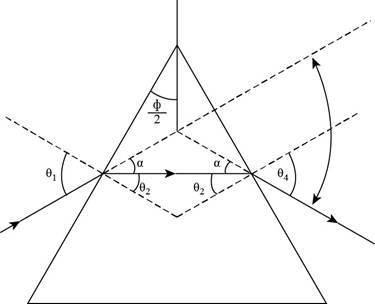
Concept explainers
A triangular glass prism with apex angle 60.0° has an index of refraction of 1.50. (a) Show that if its angle of incidence on the first surface is θ1 = 48.6°, light will pass symmetrically through the prism as shown in Figure 34.16. (b) Find the angle of deviation δmin for θ1 = 48.6°. (c) What If? Find the angle of deviation if the angle of incidence on the first surface is 45.6°. (d) Find the angle of deviation if θ1 = 51.6°.
(a)
To show: Light will pass symmetrically through the prism if the angle of incidence on the first surface
Answer to Problem 35.28P
Explanation of Solution
Given information: The apex angle is
The diagram for the given condition is shown below.

Figure (1)
Apply Snell’s law of refraction at the first interface.
The Snell’s law of refraction is,
Here,
Substitute
Apply Snell’s law of refraction at the second interface.
The Snell’s law of refraction is,
Here,
Substitute
Since,
Conclusion:
Therefore, the light will pass symmetrically through the prism.
(b)
Answer to Problem 35.28P
Explanation of Solution
Given information: The apex angle is
The angle of minimum deviation
Here,
Substitute
Conclusion:
Therefore, the orientation angle in the proper frame is
(c)
Answer to Problem 35.28P
Explanation of Solution
Given information: The apex angle is
Apply Snell’s law of refraction at the first interface.
The Snell’s law of refraction is,
Here,
Substitute
Apply Snell’s law of refraction at the second interface.
The Snell’s law of refraction is,
Here,
Substitute
The angle of minimum deviation
Here,
Substitute
Conclusion:
Therefore, the orientation angle in the proper frame is
(d)
Answer to Problem 35.28P
Explanation of Solution
Given information: The apex angle is
Apply Snell’s law of refraction at the first interface.
The Snell’s law of refraction is,
Here,
Substitute
Apply Snell’s law of refraction at the second interface.
The Snell’s law of refraction is,
Here,
Substitute
The angle of minimum deviation
Here,
Substitute
Conclusion:
Therefore, the orientation angle in the proper frame is
Want to see more full solutions like this?
Chapter 35 Solutions
Bundle: Physics for Scientists and Engineers, Technology Update, 9th Loose-leaf Version + WebAssign Printed Access Card, Multi-Term
 College PhysicsPhysicsISBN:9781285737027Author:Raymond A. Serway, Chris VuillePublisher:Cengage Learning
College PhysicsPhysicsISBN:9781285737027Author:Raymond A. Serway, Chris VuillePublisher:Cengage Learning College PhysicsPhysicsISBN:9781305952300Author:Raymond A. Serway, Chris VuillePublisher:Cengage Learning
College PhysicsPhysicsISBN:9781305952300Author:Raymond A. Serway, Chris VuillePublisher:Cengage Learning Physics for Scientists and EngineersPhysicsISBN:9781337553278Author:Raymond A. Serway, John W. JewettPublisher:Cengage Learning
Physics for Scientists and EngineersPhysicsISBN:9781337553278Author:Raymond A. Serway, John W. JewettPublisher:Cengage Learning Physics for Scientists and Engineers with Modern ...PhysicsISBN:9781337553292Author:Raymond A. Serway, John W. JewettPublisher:Cengage Learning
Physics for Scientists and Engineers with Modern ...PhysicsISBN:9781337553292Author:Raymond A. Serway, John W. JewettPublisher:Cengage Learning Physics for Scientists and Engineers: Foundations...PhysicsISBN:9781133939146Author:Katz, Debora M.Publisher:Cengage Learning
Physics for Scientists and Engineers: Foundations...PhysicsISBN:9781133939146Author:Katz, Debora M.Publisher:Cengage Learning Physics for Scientists and Engineers, Technology ...PhysicsISBN:9781305116399Author:Raymond A. Serway, John W. JewettPublisher:Cengage Learning
Physics for Scientists and Engineers, Technology ...PhysicsISBN:9781305116399Author:Raymond A. Serway, John W. JewettPublisher:Cengage Learning





